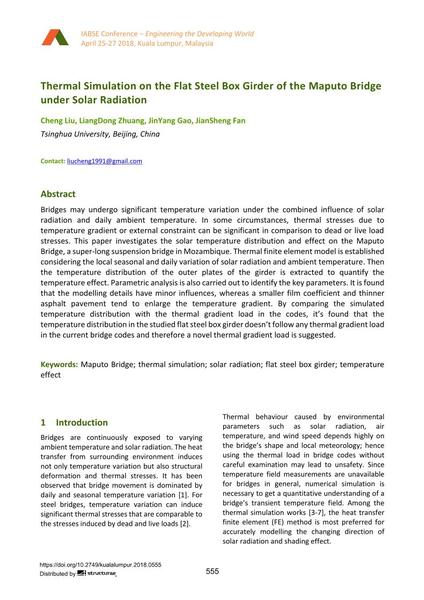Thermal Simulation on the Flat Steel Box Girder of the Maputo Bridge under Solar Radiation

|
|
|||||||||||
Détails bibliographiques
| Auteur(s): |
Cheng Liu
(Tsinghua University, Beijing, China)
Jiansheng Fan (Tsinghua University, Beijing, China) Liangdong Zhuang (Tsinghua University, Beijing, China) JinYang Gao (Tsinghua University, Beijing, China) |
||||
|---|---|---|---|---|---|
| Médium: | papier de conférence | ||||
| Langue(s): | anglais | ||||
| Conférence: | IABSE Conference: Engineering the Developing World, Kuala Lumpur, Malaysia, 25-27 April 2018 | ||||
| Publié dans: | IABSE Conference Kuala Lumpur 2018 | ||||
|
|||||
| Page(s): | 555-562 | ||||
| Nombre total de pages (du PDF): | 8 | ||||
| DOI: | 10.2749/kualalumpur.2018.0555 | ||||
| Abstrait: |
Bridges may undergo significant temperature variation under the combined influence of solar radiation and daily ambient temperature. In some circumstances, thermal stresses due to temperature gradient or external constraint can be significant in comparison to dead or live load stresses. This paper investigates the solar temperature distribution and effect on the Maputo Bridge, a super-long suspension bridge in Mozambique. Thermal finite element model is established considering the local seasonal and daily variation of solar radiation and ambient temperature. Then the temperature distribution of the outer plates of the girder is extracted to quantify the temperature effect. Parametric analysis is also carried out to identify the key parameters. It is found that the modelling details have minor influences, whereas a smaller film coefficient and thinner asphalt pavement tend to enlarge the temperature gradient. By comparing the simulated temperature distribution with the thermal gradient load in the codes, it’s found that the temperature distribution in the studied flat steel box girder doesn’t follow any thermal gradient load in the current bridge codes and therefore a novel thermal gradient load is suggested. |
||||
